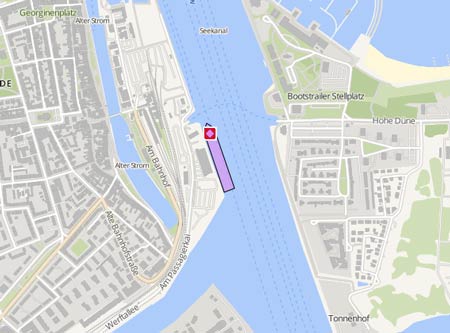US GOV VESSEL
Course/Position
Latest ports
Latest Waypoints
Latest news
US Navy released disciplinary records related to fire
The US Navy has released records from Admiral’s Mast disciplinary hearings held late last year in connection to the fire aboard the 'Bonhomme Richard'. The commanding officer at the time, Capt. Gregory Thoroman, received a written reprimand and $5,000 pay forfeiture at his December 2021 mast hearing, which was convened by the head of U.S. Pacific Fleet, Adm. Samuel Paparo. Thoroman was found to have violated the Uniform Code of Military Justice’s Article 92 by failing “in his absolute responsibility for the safety, well-being and efficiency of the ship.” The other officers and senior enlisted sailors who had mast hearings were also found to have violated Article 92, failure to obey an order or regulation. Thoroman’s second-in-command at the time, Capt. David M. Ray, also received a written reprimand and a $5,000 fine for failing to ensure that the 'Bonhomme Richard'’s crew understood and observed firefighting safety precautions aboard the ship, and for failing to ensure the command was advised on the ship’s survivability readiness, according to the records. The ship’s command master chief at the time, Master Chief Damage Controlman Jose Hernandez Jr., received a written reprimand for failing “to actively teach, uphold and enforce standards,” and for negligently failing to advise Thoroman “in matters pertaining to welfare, utilization and training of sailors.” The 'Bonhomme Richard'’s chief engineering officer, a damage control assistant and a chief damage controlman were also taken to mast, although their names are redacted in the records released to the public. Each received a written reprimand for their offenses. The Admiral’s Mast records release came roughly two months after a military judge acquitted a junior enlisted sailor whom the Navy had charged with starting the blaze. Ryan Sawyer Mays’ acquittal in September came after a nine-day trial in which no physical evidence tying Mays to the fire was presented. His defense attorneys also questioned the credibility of a key witness. The Navy announced in July that it had disciplined more than two dozen services members for their roles in the fire, and the cascade of systemic failures that allowed the ship to burn for several days. Chief among the actions was a letter of censure issued by Navy Secretary Carlos Del Toro against now-retired Vice Adm. Richard Brown, who was serving as the commander of Naval Surface Forces when the blaze occurred.
U.S. Pacific Fleet has released the results of admiral’s masts
The U.S. Pacific Fleet has released the results of admiral’s masts held for the former leadership and crew members of the 'Bonhomme Richard'. The former commander Capt. Gregory Thoroman, executive officer Capt. Michael Ray and the ship’s senior enlisted sailor, Command Master Chief Jose Hernandez, were all found guilty of violations of Article 92 – failure to obey an order or regulation – for their roles in the 2020 fire that resulted in the loss of the ship. The other three sailors punished at mast include an unidentified damage control officer, Bonhomme Richard’s chief engineer and a senior enlisted damage control sailor. The heaviest penalties fell on Thoroman and Ray, who were each fined $5,000 and given written reprimands for their role in the fire. Thoroman was found guilty at mast of two specifications of violating Article 92 – violating Navy regulations to adequately train his crew and dereliction of duty in that he “negligently failed in his absolute responsibility for the safety, well-being and efficiency of the ship, as it was his duty to do.” He faced three other specifications under the charge, but they were redacted in the charge sheet. Executive officer Ray was found guilty of Article 92 in two specifications of dereliction of duty in that he “negligently failed to ensure that firefighting safety precautions aboard Bonhomme Richard in an availability were understood and strictly observed” and “negligently failed to keep the command advised of the status of the ship’s survivability readiness,” according to the charges. Ray faced two other specifications under the charge, but they were redacted in the charge sheet. CMC Hernandez received a written reprimand for Article 92 violations under two specifications for dereliction of duty by failing to enforce crew standards aboard Bonhomme Richard during his time as CMC and failing to advise Thoroman of the welfare of the crew. Hernandez faced at least one other specification under the charge, but they were redacted in the charge sheet. The Navy issued a written reprimand to an unidentified commander who served as the damage control assistant for violating three specifications under Article 92. The three specifications are violating a direct order from Thoroman by entering the ship during the fire on July 14, 2020, failing to oversee the “prevention and control of damage” prior to the fire and failing to properly train and supervise the ship’s in port emergency team. The officer faced two other specifications under the charge, but they were redacted in the charge sheet. The ship’s chief engineer was found guilty of violating Article 92 in two specifications for failing to provide backup power to the ship and failing to stow hazardous materials. The Navy issued him a written reprimand. The chief engineer faced seven other specifications under the charge, but they were redacted in the charge sheet. A ship’s damage controlman chief petty officer was found guilty of violating Article 92 in one specification for failing to repair two of the ship’s Aqueous Film Forming Foam stations aboard the ship. The chief petty officer faced four other specifications under the charge, but they were redacted in the charge sheet.
Ryan Sawyer Mays found not guilt of arson
A Navy judge ruled on Sep 30 that Ryan Sawyer Mays was not guilty of setting a fire that destroyed the USS 'Bonhomme Richard' in San Diego. The ruling came after a nine-day trial at the Naval Base San Diego. Ryan Sawyer Mays had been charged with arson and the willful hazarding of a ship: “Seaman Recruit Mays was found not guilty on the charges of willful hazarding of a vessel and aggravated arson. The Navy is committed to upholding the principles of due process and a fair trial,” said Lt. Samuel R. Boyle, spokesman for U.S. 3rd Fleet. Prosecutors accused then-19-year-old Mays of igniting cardboard boxes in a lower vehicle storage area to drive home an earlier text to his division officer that the ship was so cluttered with contractors’ stuff it was “hazardous as expletive.” They contended that Mays was angry and vengeful about failing to become a Navy SEAL and being assigned to deck duty and ignited the ship to send a message. There is no physical evidence, however, tying Mays to the fire on the ship, which was docked and undergoing maintenance at that time. The prosecution acknowledged that a Navy report last year concluded the fire that destroyed the $1.2 billion amphibious assault ship was preventable and unacceptable and that there were lapses in training, coordination, communications, fire preparedness, equipment maintenance and overall command and control. The failure to extinguish or contain the fire led to temperatures exceeding 1,200 degrees (649 Celsius) in some areas, melting sections of the ship into molten metal that flowed into other parts of the ship. Defense lawyers argued the trial exposed a shoddy probe by government investigators who rushed to judgment and failed to collect evidence showing that the culprit also could have been lithium ion batteries or a sparking forklift instead of arson. The prosecution said that investigators found no scientific data to back the theory that batteries or a forklift malfunction sparked the inferno, while testimony from fellow shipmates bolstered the case against Mays along with his own words when he was being escorted in handcuffs and blurted out, according to the sailor escorting him to the brig: “It had to be done. I did it.” The defense said Mays, known for being flippant, was being sarcastic after denying doing it more than 150 times during 10 hours of questioning by investigators.
Upload News


